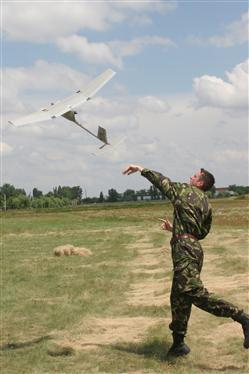 U.S. Marines and soldiers with Black Sea Rotational Force 11 travelled to Buzau, Romania recently to provide the Romanian army a familiarisation course to display the capabilities of the Raven-B, unmanned aircraft.
U.S. Marines and soldiers with Black Sea Rotational Force 11 travelled to Buzau, Romania recently to provide the Romanian army a familiarisation course to display the capabilities of the Raven-B, unmanned aircraft.
This familiarisation course was presented over five days and was split between classroom lectures and practical application exercises, where Romanian soldiers were given some stick time on the Raven system.
The Raven operates at a maximum service ceiling of 10,500 feet and each unit costs about $36,000; which is a small price to pay for the immense advantage the Raven system can generate on the battlefield. “It’s a reconnaissance bird, once it’s in the air we can achieve a certain altitude where people on the ground can’t see it above and we can loiter over them and see what they’re doing, see if they’re friend or foe and give a view of the battlefield before we get there,” said U.S. Army SSgt. Stephen Provence, Raven operator. “It has night and day capabilities, so we can see white hot or black hot. It’s easy to pick up signatures from above and it’s a great asset to the team.”
At only 4 lbs. the Raven weighs less than a loaded M-4 service carbine with magazine. Coupled with the flight systems it weighs less than an M-249 Squad Automatic Weapon with a combat load of ammunition. The Raven is constructed of thin Kevlar material, making it a hardy piece of gear that is water resistant. The Raven can be equipped with up to three cameras; one aiming forward and one on either side of the nose cone. These cameras can capture video footage and still photographs regardless of the time of day.
Adding a Raven system at the squad level would equip them to have an immediate eye in the sky, affording troops on the ground the capability to not only conduct route reconnaissance but shoot back real-time video back to the company commander, keeping him one step ahead of the enemy and allowing him to move resources as the battlefield or scenario dictates.
“[The Raven] is great for smaller level things: base security for small bases, route recon, patrolling, and things like that,” explained Sgt. Joshua Waters-Jackson, intelligence specialist/RAVEN operator, BSRF-11.
“If we would’ve had the Raven during my deployments our confidence level would’ve been way higher. There were several times when an asset like that would’ve been a force multiplier; we would’ve been able to get behind the bad guys, stop them from running away or at least follow them, because our biggest issue was positive identification of the enemy,” added Waters-Jackson.
During this familiarization course, the Romanian soldiers were given classes illustrating the physical characteristics of the Raven system to include: materials, assembly, maintenance, storage and components. Once the soldiers had a basic understanding of the physical specifications of the Raven, they were taught how to use the operating system, which includes a laptop computer and a global positioning system. The soldiers were given the opportunity to input missions, establish waypoints and synchronize the GPS.
“We were able to learn many things in the classes,” said Warrant Officer Marius Enache, Romanian Army. “I like this equipment. I like using it and it is simple to use. It is a small and intelligent air vehicle and I hope we get the opportunity to explore its capabilities more in the future.”
Once the classroom portion was completed it was time to take to Kevlar wings for some practical application and some flight time. Under the watchful eye of Provence and the RAVEN operators the Romanian soldiers took turns plotting mission waypoints and piloting the RAVEN around a large field outside the classroom. Learning the Raven system could prove important for Romanian soldiers, as the system is widely used in Afghanistan by U.S. forces, who work with and patrol alongside Romanian soldiers there.
Black Sea Rotational Force 11 is a rotational deployment of Marines to the Black Sea, Balkan and Caucasus regions to work with foreign nations and help build their military training capacity, promote stability throughout the region, and build enduring partnerships with 13 nations throughout Eastern Europe. They are slated to return to the United States, September.
Source: Marines
